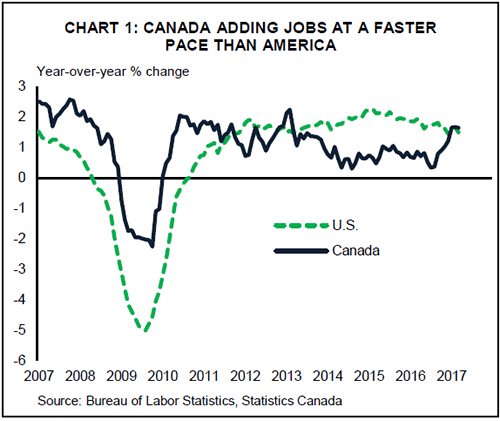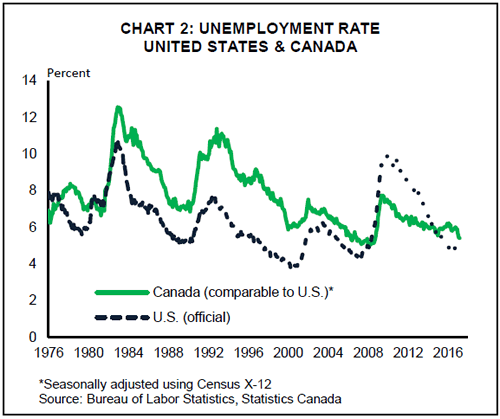HIGHLIGHTS OF THE WEEK
United States
- U.S. economic data disappointed on a variety of fronts this week, but much can be chalked up to weatherrelated disruptions to the data.
- A paltry 89k payrolls gain was the biggest disappointment, but we are inclined to look past one month’s result and focus on a new cyclical low in unemployment and continued improvement in measures of underemployment. These should also help support a rebound in consumer spending through the remainder of 2017.
- In other news, the Fed is starting to discuss the process of unwinding its holdings of Treasuries and mortgage-backed securities (MBS). It pledged that moves will be well-telegraphed and are likely to start later this year.
Canada
- It is getting more and more difficult to ignore the good news out of the Canadian economy. This was evident again this week as labour market data showed a fourth straight month of consensus-busting job growth.
- The economy generated 19.4k jobs in March, almost all of them full-time (+18.4k). While the unemployment rate ticked up to 6.7% (from 6.6%), this was due to more people joining the labor market – arguably a good problem to have.
- Canada may have started the year with more slack than its southern neighbor, but the differential is closing. Even with a slowdown in economic growth relative to its recent torrid pace, slack is likely to continue to diminish. As it does, the case for the Bank of Canada to move off the sidelines will strengthen.
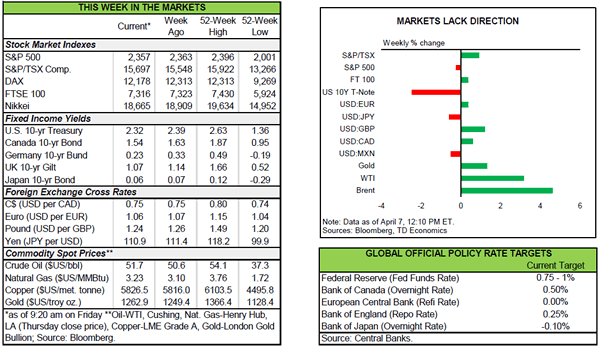
UNITED STATES – BLAME IT ON THE WEATHER
March payrolls data disappointed expectations, with only 98k new jobs in March, and downward revisions to hiring in January and February. A softer reading was expected after two heady months, but a 200+ reading in the closely watched ADP report earlier in the week had raised hopes. Hiring slowed across both the goods and services sectors, although it was more dramatic in services. Despite the unexpectedly weak payroll print, the household survey showed employment gain of 472k, pushing the unemployment rate down by 0.2 percentage points to 4.5%.
We are inclined to look past one month’s payrolls disappointment. Weather played a role in the March data on two fronts. Unusually warm weather in January and February likely pulled forward activity in the construction sector. And, data on curtailment of hours due to bad weather was nearly ten times larger than average in March, impacting hours worked, earnings and potentially hiring.
The job market should continue to provide a solid foundation for consumer spending this year, with the unemployment rate near pre-recession lows in March, and continued improvement in measures of underemployment.
Other data this week confirmed that consumers took a breather once again in Q1, but we expect a rebound in spending in Q2, much like we saw last year. Q1 weakness has become a pattern. Consumer spending growth averaged 2% in Q1 over the past 4 years, while the other three quarters of the year have averaged above 3% (see chart). Eventually, this pattern will be fixed by adjustment to "seasonal adjustment," but for now we are inclined to discount Q1 weakness.
The Fed minutes also provided a peek into the FOMC’s discussion of how and when it will start the process of normalizing its balance sheet, now that normalizing rates is underway. Through the course of its asset purchase program, the Fed accumulated $4.5 trillion in Treasuries and MBS. Since purchases ended, the Fed has been reinvesting the principal payments, keeping its balance sheet steady.
Although things are still at the discussion phase, Fed members already agree on a few things. First, the process of ending reinvestments should be gradual and predictable, and rely primarily on passive phasing out of reinvestments. Second, most members agreed that the change in reinvestment policy should come this year. Third, the FOMC was unanimous that any policy change should be well telegraphed to the public. Our recent forecast calls for the Fed to hike rates in two 25 basis point moves, likely in June and September, and then lay out the plan to start winding down reinvestments. Once reinvesting principal payments is completely phased out, the balance sheet will passively shrink as the securities mature.
Markets are watching closely since removing the Fed from these markets could reduce demand for these securities, lowering prices, and taking yields higher, all else equal. Our latest forecast calls for a continued rise in Treasury yields, and balance sheet normalization is one of the forces expected to take yields higher. The Fed has control of this process. If the Fed doesn’t like the market reaction as it winds down reinvestments, it has the discretion to slow down or stop the pace of adjustment. This helps to mitigate the risks of an undesirable spike in yields.
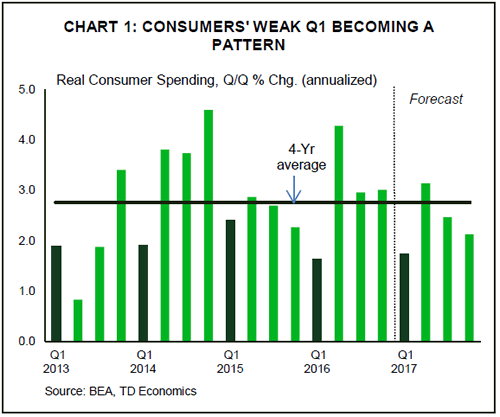
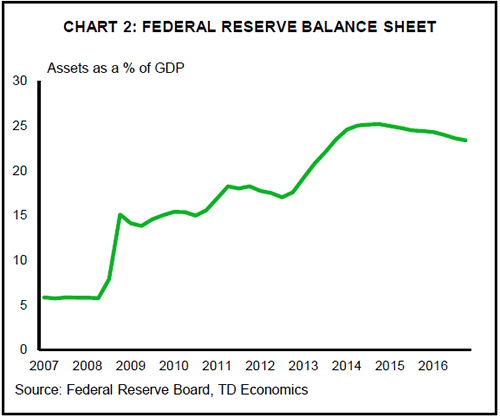
CANADA – I GET KNOCKED DOWN, BUT I GET UP AGAIN
It is getting more and more difficult to ignore the good news out of the Canadian economy. This was evident again this week as labour market data showed a fourth straight month of consensus-busting job growth. The economy generated 19.4k jobs in March, almost all of them full-time (+18.4k). While the unemployment rate ticked up to 6.7% (from 6.6%), this was due to more people joining the labor market – arguably a good problem to have.
The positive turn in economic momentum has come as data in the United States has moved in the opposite direction. Job growth south of the border slowed in March to just 98k. On a year-on-year basis, employment growth in Canada has been running faster than in the United States for the past three months. The difference is not large, but it marks a change from the previous four years in which the U.S. was adding jobs at a relatively faster clip (Chart 1).
The divergence is not just a jobs story. Even with the pullback in exports in February that returned the country’s trade balance to a slight trade deficit (following three months in surplus), Canada’s economy is tracking growth of 3.4% (annualized) in the first quarter. Meanwhile, stateside, real GDP looks to advance by just 1.0%.
The outperformance in Canadian economic data relative to the U.S. may reflect the fact that Canada simply has a bigger hole to fill. Indeed, countries with more slack should be expected to grow relatively faster. Despite the slowdown in job growth in the U.S., the unemployment rate fell to 4.5% in March, widely considered its long-run (or natural rate).
Yet, it is not so straightforward to make the case that Canada has a lot more slack than America. On a comparable basis, the Canadian unemployment rate was 5.4% (seasonally adjusted) in March, 0.9 percentage points above the U.S. rate. But, Canadian unemployment rates have always run higher than U.S. rates. The current differential is the same as it was prior to the Great Recession, and lower than its longer-run historical average of 1.3 percentage points (Chart 2). By other metrics, the Canadian labor market is the tightest it’s been since the recession. The employmentto- population ratio of core working age people (25 to 54) rose to 82.3% in March, its highest level since mid-2008.
The worry among policymakers is that Canadian economic growth is built on shaky foundations. Canada has seen false starts before – economic growth started last year with similar spark. However, that was largely an export story, and net-trade is likely to subtract from growth in the this year. At the same time, the current strength in key housing markets is unsustainable over the medium term, but there appears little on the horizon to impede near term momentum. Finally, government stimulus dollars should begin translating more meaningfully into activity this year, helping to maintain Canada’s growth trajectory.
All told, Canada may have started the year with more slack than its southern neighbor, but the differential is closing swiftly. Even with a slowdown in economic growth relative to its recent torrid pace, slack is likely to continue to diminish. As it does, the case for the Bank of Canada to move off the sidelines will strengthen.
